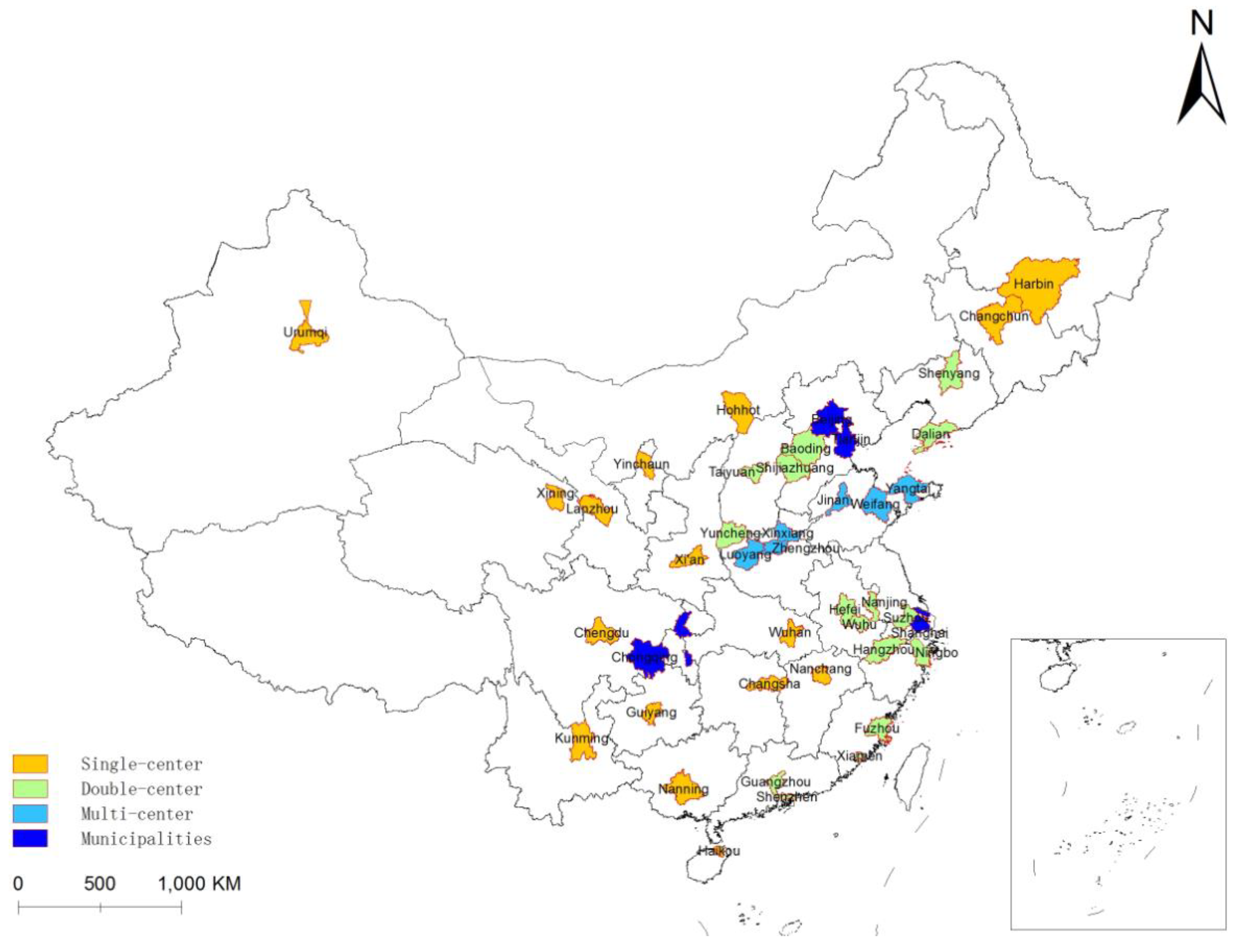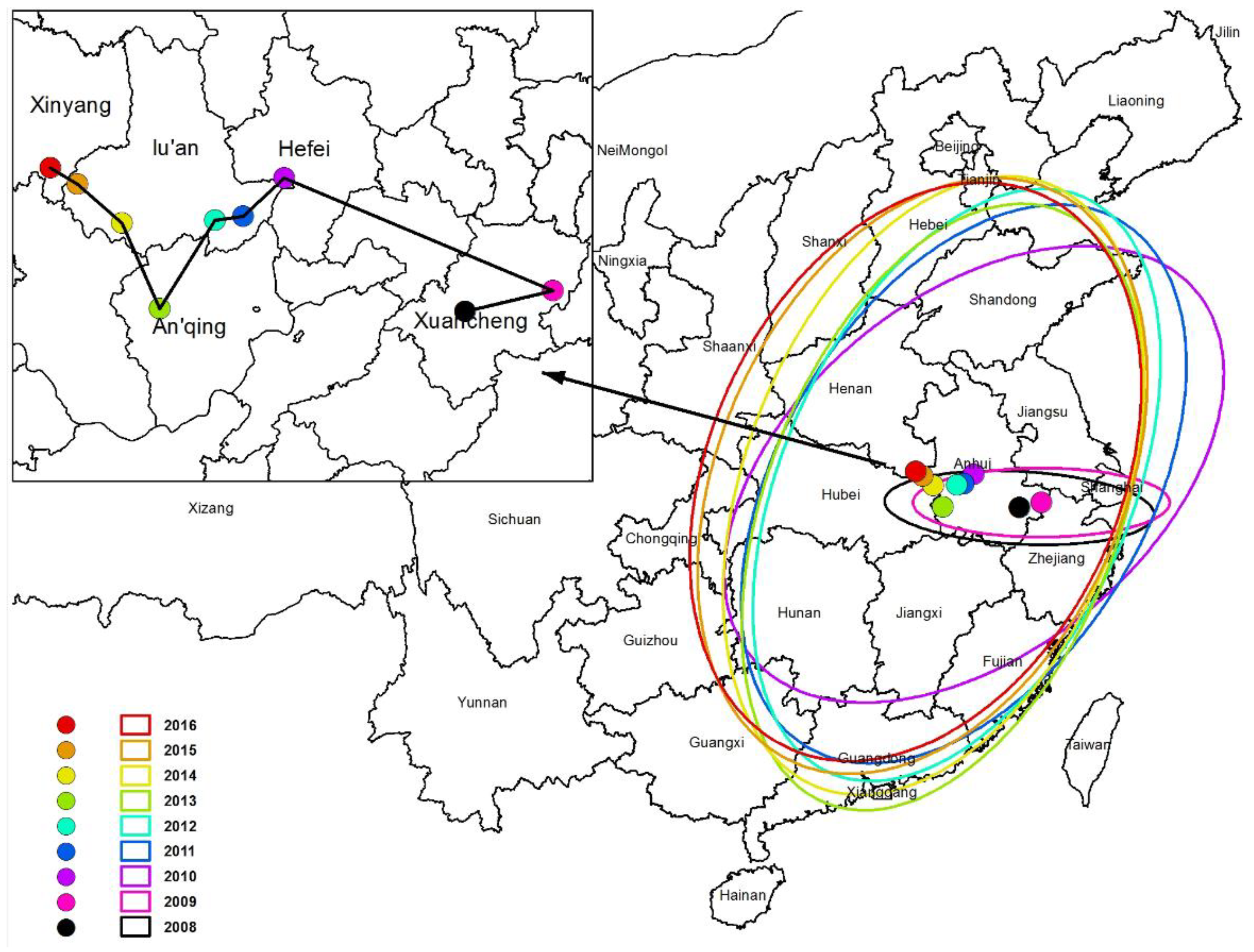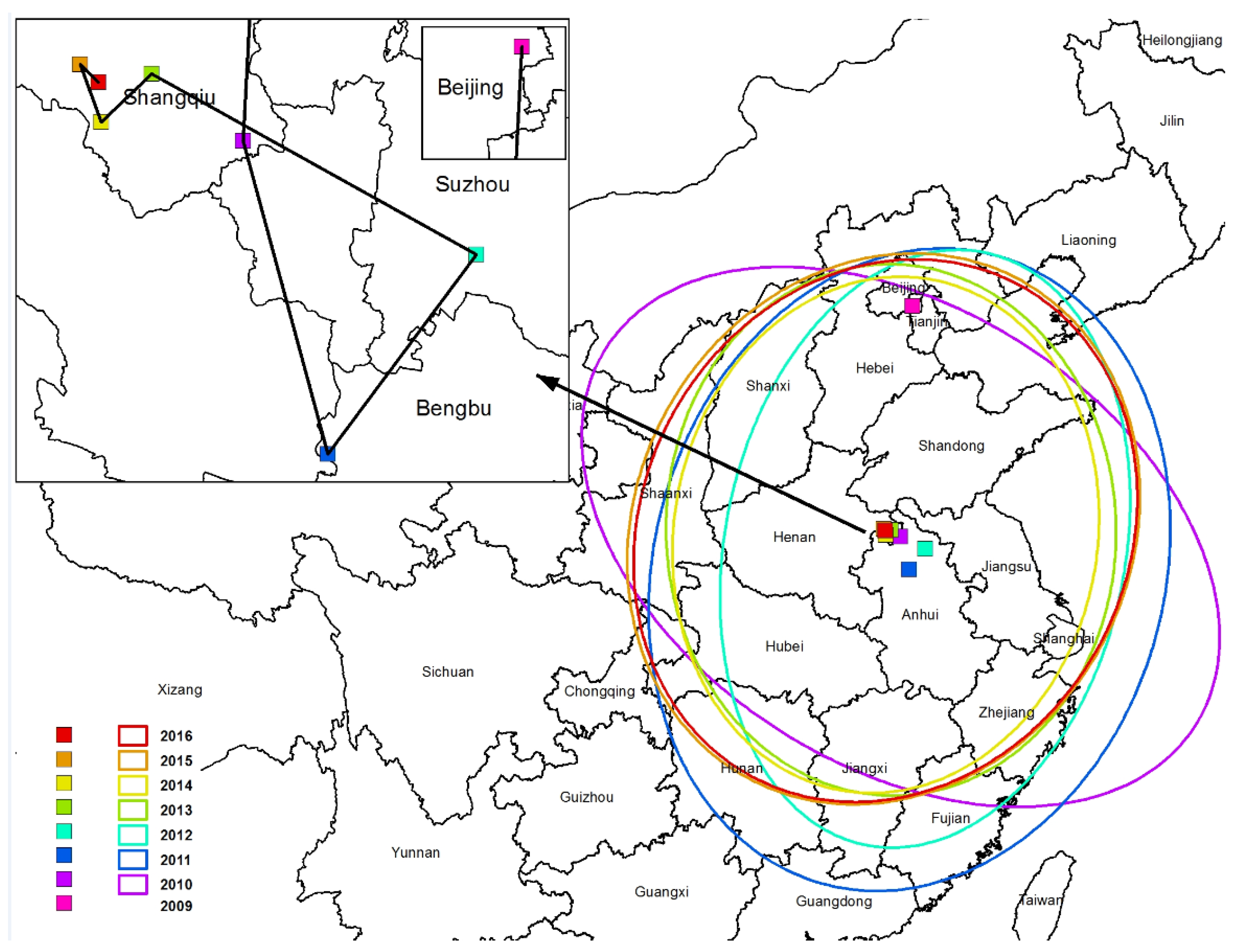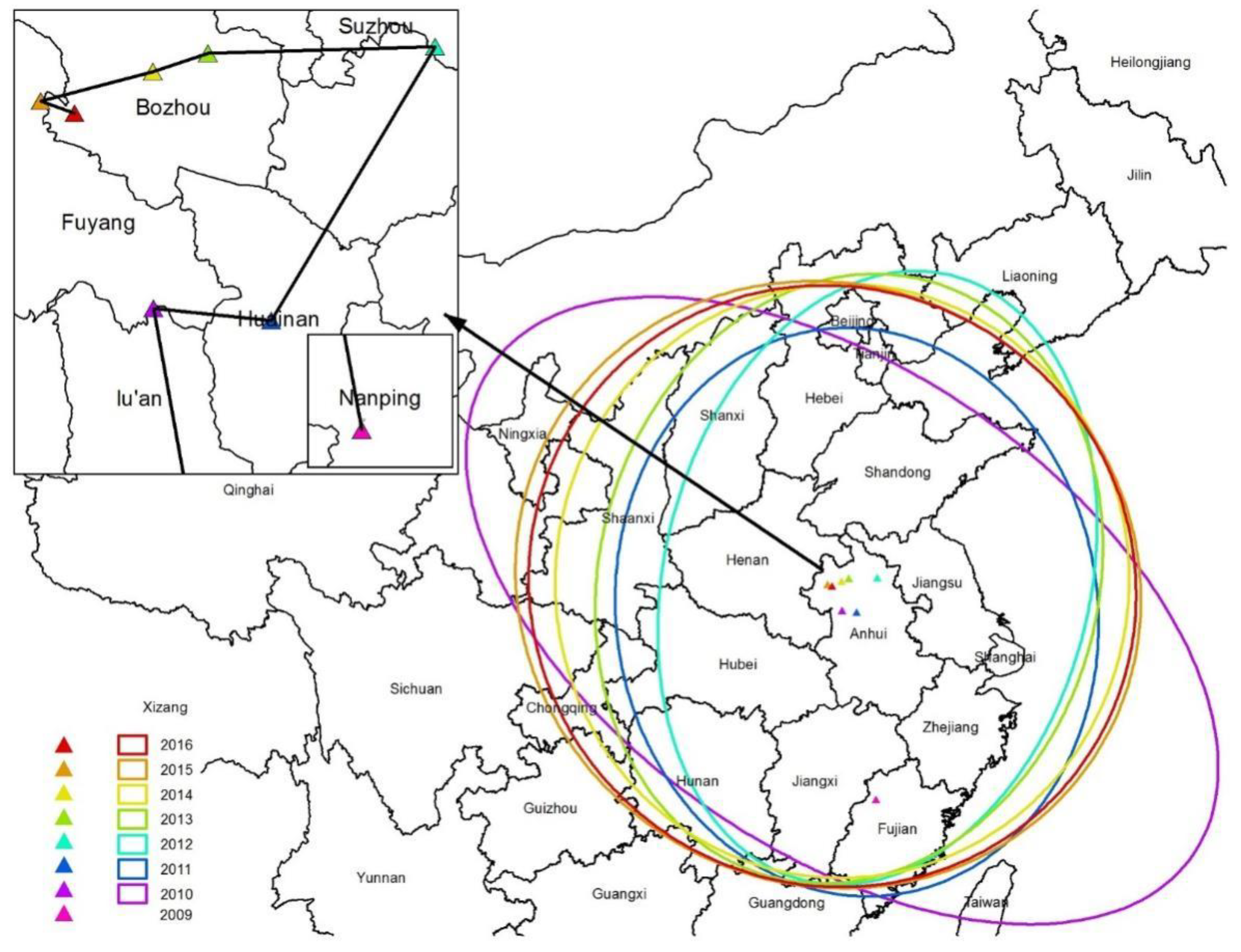Research on Spatial and Temporal Evolution Trends and Driving Factors of Green Residences in China Based on Weighted Standard Deviational Ellipse and Panel Tobit Model
Abstract
:1. Introduction
2. Literature Review
3. Research Ranges, Objects and Methods
3.1. Research Ranges
3.2. Research Objects
3.2.1. Green Residence Development Indicator
3.2.2. Driving Factors for Green Residences Development
3.3. Research Methods
3.3.1. Weighted Standard Deviation Ellipse
3.3.2. Spearman’s Correlation Analysis
3.3.3. Panel Tobit Regression Analysis
3.3.4. Average Marginal Effect
4. The Spatial and Temporal Evolution Trends of Green Residences in China
4.1. The Spatial and Temporal Evolution of One-Star Green Residences
4.2. The Spatial and Temporal Evolution of Two-Star Green Residences
4.3. The Spatial and Temporal Evolution of Three-Star Green Residences
4.4. Summary
5. The Driving Mechanism and Key Driving Factors of Green Residences in China
5.1. Correlation Analysis
5.2. Regression Analysis
6. Conclusions
Author Contributions
Funding
Institutional Review Board Statement
Informed Consent Statement
Data Availability Statement
Acknowledgments
Conflicts of Interest
Appendix A
| Dimension | Code | Driving Factors |
|---|---|---|
| Economic Factor | GDP | Gross domestic product |
| RGPB | Revenue in the general public budgets | |
| Social Environment | EECEP | Expenditure on energy conservation and environmental protection |
| AQI | Air quality index | |
| PRP | Permanent resident population | |
| UR | Urbanization rate | |
| UCDI | Urban per capita disposable income | |
| UCHA | Urban Per capita housing area | |
| PPEU | Proportion of population with an education above university level | |
| The Real Estate Market | COV | Cross-output value of the construction industry |
| ICR | Investment in commercial residences | |
| CRCNA | Commercial residential construction area | |
| CRCMA | Commercial residential completion area | |
| CRSA | Commercial residential sale area | |
| CRP | Commercial residential price | |
| Government Measure | CP | Compulsory policy |
| EIP | Economic incentive policy | |
| NEIP | Non-economic incentive policy | |
| DE | Demonstration effect | |
| GE | Guidance effect | |
| Climatic Condition | CRA | Climate regionalization for architecture |
References
- IPCC. Chapter 9: Buildings. Climate Change 2014: Mitigation of Climate Change. In Contribution of Working Group III to the Fifth Assessment Report of the Intergovernmental Panel on Climate Change; Edenhofer, O., Pichs-Madruga, R., Sokona, Y., Farahani, E., Kadner, S., Seyboth, K., Adler, A., Baum, I., Brunner, S., Eickemeier, P., et al., Eds.; Cambridge University Press: Cambridge, UK; New York, NY, USA, 2014; pp. 677–678. Available online: https://www.ipcc.ch/report/ar5/wg3/ (accessed on 13 January 2022).
- China Building Energy Consumption Research Report (2020) Released. Available online: https://cabee.org/site/content/24021.html (accessed on 3 February 2021).
- Lian, S.H.; Liang, H. Comparative Study on Green Building Development between China and Foreign Countries. Constr. Sci. Technol. 2021, 75–80. [Google Scholar] [CrossRef]
- Darko, A.; Zhang, C.; Chan, A.P.C. Critical analysis of green building research trend in construction journals. Habitat. Int. 2016, 57, 53–63. [Google Scholar] [CrossRef]
- Assessment Standard for Green Building (National Standard of the People’s Republic of China, GB/T 50378-2019). Available online: http://www.mohurd.gov.cn/gongkai/fdzdgknr/tzgg/201905/20190530_240717.html (accessed on 29 August 2022).
- Kats, G. The Costs and Financial Benefits of Green Buildings: A Report to California’s Sustainable Building Task Force 2003. Available online: http://citeseerx.ist.psu.edu/viewdoc/download;jsessionid=EE14BBCE4C2EF6E6315B38857249245D?doi=10.1.1.174.2149&rep=rep1&type=pdf (accessed on 19 October 2021).
- Zhang, L.; Wu, J.; Liu, H. Turning green into gold: A review on the economics of green buildings. J. Clean. Prod. 2018, 172, 2234–2245. [Google Scholar] [CrossRef]
- Wu, X.; Peng, B.; Lin, B. A dynamic life cycle carbon emission assessment on green and non-green buildings in China. Energy Build. 2017, 149, 272–281. [Google Scholar] [CrossRef]
- Song, Y.; Li, C.; Zhou, L.; Chen, Y.; Zhang, H. Factors affecting green building development at the municipal level: A cross-sectional study in China. Energy Build. 2021, 231, 110560. [Google Scholar] [CrossRef]
- Liu, X.; Li, P. Spatial and Temporal Evolution and Driving Mechanism of Green Building Area in China. Ecol. Econ. 2021, 37, 88–94, 142. [Google Scholar]
- Yip, S.C.T. The Geography of Green Buildings in Chinese Cities. Mod. Urban Res. 2012, 27, 42–48. [Google Scholar]
- Qiu, B.; Li, D.; Wu, Z. Study on the Character of Chinese Green Building Spatial Evolution. Urban Stud. 2017, 24, 1–10. [Google Scholar]
- Zhang, L.; Wu, J.; Liu, H. Policies to enhance the drivers of green housing development in China. Energy Policy 2018, 121, 225–235. [Google Scholar] [CrossRef]
- Choi, E.; Miller, N. Explaining LEED Concentration: Effects of Public Policy and Political Party. JOSRE 2011, 3, 91–108. [Google Scholar] [CrossRef]
- Dippold, T.; Mutl, J.; Zietz, J. Opting for a Green Certificate: The Impact of Local Attitudes and Economic Conditions. J. Real Estate Res. 2014, 36, 435–474. [Google Scholar] [CrossRef]
- Kaza, N.; Lester, T.W.; Rodriguez, D.A. The Spatio-temporal Clustering of Green Buildings in the United States. Urban Stud. 2013, 50, 3262–3282. [Google Scholar] [CrossRef]
- Simons, R.A.; Choi, E.; Simons, D.M. The effect of state and city green policies on the market penetration of green commercial buildings. JOSRE 2009, 1, 139–166. [Google Scholar] [CrossRef]
- Cidell, J.; Cope, M.A. Factors explaining the adoption and impact of LEED-based green building policies at the municipal level. J. Environ. Plan. Manag. 2014, 57, 1763–1781. [Google Scholar] [CrossRef]
- Gao, Y.; Yang, G.; Xie, Q. Spatial-Temporal Evolution and Driving Factors of Green Building Development in China. Sustainability 2020, 12, 2773. [Google Scholar] [CrossRef]
- Lee, T.; Koski, C. Building green: Local political leadership addressing climate change. Rev. Policy Res. 2012, 29, 605–624. [Google Scholar] [CrossRef]
- Portney, K.E.; Cuttler, Z. The local nonprofit sector and the pursuit of sustainability in American cities: A preliminary exploration. Local Environ. 2010, 15, 323–339. [Google Scholar] [CrossRef]
- Fuerst, F.; Kontokosta, C.; McAllister, P. Determinants of green building adoption. Environ. Plan. B Urban Anal. City Sci. 2014, 41, 551–570. [Google Scholar] [CrossRef]
- Mason, S.G.; Marker, T.; Mirsky, R. Primary Factors Influencing Green Building in Cities in the Pacific Northwest. Public Works Manag. P 2011, 16, 157–185. [Google Scholar] [CrossRef]
- Portnov, B.A.; Trop, T.; Svechkina, A.; Ofek, S.; Ghermandi, A. Factors affecting homebuyers’ willingness to pay green building price premium: Evidence from a nationwide survey in Israel. Build. Environ. 2018, 137, 280–291. [Google Scholar] [CrossRef]
- Berry, S.; Davidson, K.; Saman, W. The impact of niche green developments in transforming the building sector: The case study of Lochiel Parkf Lochiel Park. Energ. Policy 2013, 62, 646–655. [Google Scholar] [CrossRef]
- Zou, Y.; Zhao, W.; Zhong, R. The spatial distribution of green buildings in China: Regional imbalance, economic fundamentals, and policy incentives. Appl. Geogr. 2017, 88, 38–47. [Google Scholar] [CrossRef]
- Delmas, M.; Toffel, M.W. Stakeholders and environmental management practices: An institutional framework. Bus. Strategy Environ. 2004, 13, 209–222. [Google Scholar] [CrossRef]
- Karkanias, C.; Boemi, S.N.; Papadopoulos, A.M.; Tsoutsos, T.D.; Karagiannidis, A. Energy efficiency in the Hellenic building sector: An assessment of the restrictions and perspectives of the market. Energy Policy 2010, 38, 2776–2784. [Google Scholar] [CrossRef]
- Franco, M.; Pawar, P.; Wu, X. Green building policies in cities: A comparative assessment and analysis. Energy Build. 2021, 231, 110561. [Google Scholar] [CrossRef]
- Cidell, J.; Beata, A. Spatial variation among green building certification categories: Does place matter? Landsc. Urban Plan. 2009, 91, 142–151. [Google Scholar] [CrossRef]
- Yang, X.; Zhang, J.; Zhao, J. Factors Affecting Green Residential Building Development: Social Network Analysis. Sustainability 2018, 10, 1389. [Google Scholar] [CrossRef]
- Li, D. Regional Differences among the Development Models of Green Buildings in China—Based on statistical data from 2006 to 2014. Hous. Sci. 2019, 29, 35–43. [Google Scholar] [CrossRef]
- Guo, K.; Yuan, Y. Geographic Distribution and Influencing Factor Analysis of Green Residential Buildings in China. Sustainability 2021, 13, 12060. [Google Scholar] [CrossRef]
- Hao, T.; Wang, J.; Zhang, Z. Study on Spatial Evolution of Chinese Green Building. In Proceedings of the 14th International Green Building and Building Energy Conservation Conference and New Technology and Products Fair, Zhuhai, China, 2 April 2018. [Google Scholar]
- Fu, W.; Zhou, Y. Based on ARCGIS-SDE Spatial Evolution Trend of Industrial Clusters Space. Appl. Mech. Mater. 2015, 733, 982–985. [Google Scholar] [CrossRef]
- Du, Q.; Zhou, J.; Pan, T.; Sun, Q.; Wu, M. Relationship of carbon emissions and economic growth in China’s construction industry. J. Clean. Prod. 2015, 220, 99–109. [Google Scholar] [CrossRef]
- Li, Q.; Zhao, Y.; Li, S.; Zhang, L. Spatial-temporal characteristics of the coupling coordination of social security and economic development in China during 2002–2018. Reg. Sustain. 2021, 2, 116–129. [Google Scholar] [CrossRef]
- Croux, C.; Dehon, C. Influence functions of the Spearman and Kendall correlation measures. Stat. Methods Appl. 2010, 19, 497–515. [Google Scholar] [CrossRef] [Green Version]
- Zar, J. Spearman Rank Correlation. In Encyclopedia of Biostatistics; Armitage, P., Colton, T., Eds.; John Wiley & Sons Ltd.: Hoboken, NJ, USA, 2005. [Google Scholar] [CrossRef]
- Artusi, R.; Verderio, P.; Marubini, E. Bravais-Pearson and Spearman correlation coefficients: Meaning, test of hypothesis and confidence interval. Int. J. Biol. Markers 2002, 17, 148–151. [Google Scholar] [CrossRef]
- Ke, Y.; Guo, J.; He, Z.; Yin, J. Research on economic evaluation of green buildings based on the correlation analysis of factors. J. Wuhan Polytech. Univ. 2016, 35, 75–81. [Google Scholar] [CrossRef]
- Zhang, L. Study on the Driving Mechanism of Green Housing Development in Chinese Cities. Ph.D. Thesis, Tsinghua University, Beijing, China, 2018. [Google Scholar] [CrossRef]
- Mcdonald, J.; Moffitt, F. The Uses of Tobit Analysis. Rev. Econ. Stat. 1980, 2, 318–321. [Google Scholar] [CrossRef]
- Annual Report on Green Real Estate Development in China (2020). Available online: http://www.ugreen.cn/newsDetail/10106 (accessed on 3 February 2021).
- Chen, Q. Advanced Econometrics and Stata Applications, 2nd ed.; Higher Education Press: Beijing, China, 2014; pp. 325–327. [Google Scholar]




| Star Level | 2008 | 2009 | 2010 | 2011 | 2012 | 2013 | 2014 | 2015 | 2016 |
|---|---|---|---|---|---|---|---|---|---|
| 42 Leading Cities | |||||||||
| Total | 3 | 7 | 46 | 158 | 281 | 513 | 817 | 1210 | 1335 |
| One-star | 2 | 3 | 13 | 50 | 93 | 179 | 310 | 501 | 565 |
| Two-star | 2 | 23 | 61 | 123 | 245 | 361 | 528 | 572 | |
| Three-star | 1 | 2 | 10 | 47 | 65 | 89 | 146 | 181 | 198 |
| China | |||||||||
| Total | 4 | 8 | 53 | 191 | 379 | 752 | 1252 | 1845 | 2035 |
| One-star | 3 | 4 | 14 | 61 | 127 | 260 | 471 | 757 | 850 |
| Two-star | 2 | 27 | 76 | 169 | 376 | 591 | 847 | 919 | |
| Three-star | 1 | 2 | 12 | 54 | 83 | 116 | 190 | 241 | 266 |
| Ratio | |||||||||
| Total | 75% | 88% | 87% | 83% | 74% | 68% | 65% | 66% | 66% |
| One-star | 67% | 75% | 93% | 82% | 73% | 69% | 66% | 66% | 66% |
| Two-star | 100% | 85% | 80% | 73% | 65% | 61% | 62% | 62% | |
| Three-star | 100% | 100% | 83% | 87% | 78% | 77% | 77% | 75% | 74% |
| Dimension | Factor | Unit | Obs. | Mean | Min. | Max. |
|---|---|---|---|---|---|---|
| Economic Factor | GDP | CNY 100 million | 336 | 5314.3 | 439.94 | 25,643.47 |
| RGPB | CNY 100 million | 336 | 616.18 | 29.46 | 5519.5 | |
| Social Environment | EECEP | CNY 100 million | 336 | 32.98 | 0.5 | 708.83 |
| AQI | % | 336 | 81% | 12% | 100% | |
| PRP | 10,000 persons | 336 | 827.89 | 165.43 | 3016.55 | |
| UR | % | 336 | 66% | 26% | 100% | |
| UCDI | CNY | 336 | 25,827.19 | 11,290.5 | 52,962 | |
| UCHA | sq. m | 336 | 30.27 | 12.81 | 47.6 | |
| PPEU | % | 336 | 18% | 5% | 37% | |
| The Real Estate Market | COV | CNY 100 million | 336 | 1544.26 | 73.11 | 8436.7 |
| ICR | CNY 100 million | 336 | 556.09 | 22.7 | 2451.37 | |
| CRCNA | 10,000 sq. m | 336 | 3986.63 | 461.1 | 20,294.49 | |
| CRCMA | 10,000 sq. m | 336 | 683.12 | 28.13 | 3386.35 | |
| CRSA | 10,000 sq. m | 336 | 903.42 | 100.78 | 4477.71 | |
| CRBP | CNY/sq. m | 336 | 9254.6 | 1466.06 | 35,822.92 | |
| Government Measure | CP | 336 | 0 | 1 | ||
| EIP | 336 | 0 | 1 | |||
| NEIP | 336 | 0 | 1 | |||
| DE | 336 | 0 | 1 | |||
| GE | 336 | 0 | 1 | |||
| Climatic Condition | CRA | 42 | 1 | 5 |
| Grade | Year | Weighted Ellipse Center Coordinate | Rotation Angle (°) | Major Axis Standard Deviation (km) | Minor Axis Standard Deviation (km) | Ellipse Area (10,000 sq.km) | Axial Ratio |
|---|---|---|---|---|---|---|---|
| One-star | 2008 | 132.06° E, 35.63° N | 93.05 | 783.15 | 211.26 | 12.99 | 0.27 |
| 2009 | 132.85° E, 35.82° N | 89.96 | 745.7 | 200.32 | 11.73 | 0.27 | |
| 2010 | 130.43° E, 36.83° N | 50.77 | 1670.89 | 1032.27 | 135.47 | 0.62 | |
| 2011 | 130.06° E, 36.49° N | 30.8 | 1777.37 | 1067.9 | 149.07 | 0.6 | |
| 2012 | 129.80° E, 36.46° N | 23.9 | 1826.19 | 1010.28 | 144.9 | 0.55 | |
| 2013 | 129.30° E, 35.66° N | 21.38 | 1848.52 | 1023.18 | 148.55 | 0.55 | |
| 2014 | 128.97° E, 36.43° N | 20.83 | 1875.09 | 1095.09 | 161.27 | 0.58 | |
| 2015 | 128.56° E, 36.78° N | 24.3 | 1822.82 | 1172.6 | 167.87 | 0.64 | |
| 2016 | 128.32° E, 36.93° N | 24.78 | 1766.21 | 1191.37 | 165.26 | 0.68 | |
| Two-star | 2009 | 130.11° E, 48.01° N | |||||
| 2010 | 129.69° E, 39.94° N | 122.86 | 1970.71 | 1286.33 | 199.1 | 0.65 | |
| 2011 | 130.00° E, 38.79° N | 15.58 | 1834.83 | 1437.41 | 207.14 | 0.78 | |
| 2012 | 130.55° E, 39.53° N | 11.34 | 1701.76 | 1127.75 | 150.73 | 0.66 | |
| 2013 | 129.36° E, 40.19° N | 178.7 | 1496.48 | 1267.53 | 148.98 | 0.85 | |
| 2014 | 129.17° E, 40.01° N | 9.67 | 1460.54 | 1193.42 | 136.9 | 0.82 | |
| 2015 | 129.09° E, 40.22° N | 29.34 | 1598.1 | 1391.81 | 174.69 | 0.87 | |
| 2016 | 129.16° E, 40.16° N | 29.28 | 1575.33 | 1366.12 | 169.02 | 0.87 | |
| Three-star | 2009 | 130.68° E, 31.17° N | |||||
| 2010 | 129.43° E, 38.08° N | 125 | 2517.72 | 1406.03 | 278.03 | 0.56 | |
| 2011 | 129.97° E, 38.03° N | 172.58 | 1677.45 | 1418.83 | 186.93 | 0.85 | |
| 2012 | 130.72° E, 39.28° N | 13.62 | 1832.96 | 1254.53 | 180.6 | 0.68 | |
| 2013 | 129.68° E, 39.25° N | 14.59 | 1814 | 1470.78 | 209.54 | 0.81 | |
| 2014 | 129.43° E, 19.16° N | 3.92 | 1748.49 | 1689.81 | 232.06 | 0.96 | |
| 2015 | 128.92° E, 39.03° N | 119.38 | 1866.51 | 1760.94 | 258.15 | 0.94 | |
| 2016 | 129.07° E, 38.97° N | 125.2 | 1806.08 | 1753.6 | 248.75 | 0.97 |
| Variable | One-Star | Two-Star | Three-Star |
|---|---|---|---|
| GDP | 0.651 *** | 0.558 *** | 0.549 *** |
| RGPB | 0.649 *** | 0.54 *** | 0.6 *** |
| EECEP | 0.511 *** | 0.535 *** | 0.511 *** |
| AQI | −0.295 *** | −0.36 *** | −0.15 *** |
| PRP | 0.439 *** | 0.442 *** | 0.361 *** |
| UR | 0.361 *** | 0.362 *** | 0.479 *** |
| UCDI | 0.651 *** | 0.63 *** | 0.66 *** |
| UCHA | 0.303 *** | 0.339 *** | 0.278 *** |
| PPEU | 0.36 *** | 0.289 *** | 0.389 *** |
| COV | 0.623 *** | 0.452 *** | 0.52 *** |
| ICR | 0.603 *** | 0.452 *** | 0.492 *** |
| CRCNA | 0.543 *** | 0.409 *** | 0.42 *** |
| CRCMA | 0.405 *** | 0.328 *** | 0.308 *** |
| CRSA | 0.482 *** | 0.284 *** | 0.359 *** |
| CRP | 0.434 *** | 0.38 *** | 0.545 *** |
| CP | 0.318 *** | 0.244 *** | 0.317 *** |
| EIP | 0.24 *** | 0.296 *** | 0.141 *** |
| NEIP | 0.176 *** | 0.198 *** | 0.003 |
| DE | 0.329 *** | 0.34 *** | 0.486 *** |
| GE | 0.167 *** | 0.293 *** | 0.189 *** |
| CRA | 0.173 *** | 0.035 | 0.271 *** |
| Variable | One-Star | Two-Star | Three-Star | |||
|---|---|---|---|---|---|---|
| (1) | (2) | (3) | (4) | (5) | (6) | |
| GDP | 8.41 ** (3.003) | 2.694 *** (0.986) | −0.062 (0.959) | −0.024 (0.366) | 3.921 (6.191) | 0.985 (1.56) |
| RGPB | 0.784 (1.753) | 0.251 (0.562) | 0.348 (0.63) | 0.133 (0.241) | 3.01 (3.9) | 0.756 (0.981) |
| EECEP | 0.418 (0.739) | 0.134 (0.237) | 0.188 (0.276) | 0.072 (0.105) | −3.093 * (1.496) | −0.776 ** (0.384) |
| AQI | −0.278 (2.441) | −0.089 (0.782) | −0.486 (1.017) | −0.186 (0.389) | −5.713 (4.824) | −1.434 (1.215) |
| PRP | −8.224 ** (2.963) | −2.634 *** (0.969) | 0.752 (0.949) | 0.287 (0.363) | 1.191 (6.04) | 0.299 (1.517) |
| UR | 0.068 (6.154) | 0.022 (1.971) | 3.93 (2.276) | 1.501 * (0.873) | 39.45 ** (14.091) | 9.906 *** (3.687) |
| UCDI | −2.495 (3.603) | −0.799 (1.158) | 4.198 ** (1.324) | 1.604 *** (0.506) | 8.662 (6.987) | 2.175 (1.754) |
| UCHA | 0.562 (2.316) | 0.18 (0.742) | 2.698 ** (0.992) | 1.031 *** (0.38) | 14.53 ** (5.212) | 3.649 *** (1.326) |
| PPEU | −15.96 (13.757) | −5.111 (4.42) | −0.536 (4.328) | −0.205 (1.653) | −11.63 (29.842) | −2.921 (7.503) |
| COV | −0.55 (1.356) | −0.176 (0.435) | 0.278 (0.408) | 0.106 (0.156) | 1.672 (2.719) | 0.42 (0.682) |
| ICR | −0.941 (1.669) | −0.301 (0.536) | −0.776 (0.626) | −0.297 (0.24) | −9.137 * (3.866) | −2.294 ** (0.984) |
| CRCNA | 0.742 (2.137) | 0.238 (0.684) | −0.993 (0.784) | −0.379 (0.3) | 6.311 (4.725) | 1.585 (1.187) |
| CRCMA | −0.933 (1.019) | −0.299 (0.326) | 0.306 (0.403) | 0.117 (0.154) | 1.65 (1.861) | 0.414 (0.468) |
| CRSA | −0.168 (1.24) | −0.054 (0.397) | 0.211 (0.537) | 0.081 (0.205) | −1.062 (2.419) | −0.267 (0.608) |
| CRP | 1.651 (2.103) | 0.529 (0.677) | −0.371 (0.702) | −0.142 (0.268) | −1.549 (4.36) | −0.389 (1.096) |
| CP.1 | 1.423 (1.103) | 0.488 (0.405) | −0.65 (0.505) | −0.231 (0.167) | −2.156 (1.881) | −0.511 (0.423) |
| EIP.1 | −2.112 * (0.987) | −0.634 ** (0.281) | −0.201 (0.402) | −0.075 (0.149) | 0.715 (1.878) | 0.182 (0.485) |
| NEIP.1 | 3.44 ** (1.125) | 1.269 *** (0.476) | 0.794 (0.45) | 0.327 (0.199) | 0.794 (2.214) | 0.203 (0.578) |
| DE.1 | 0.169 (1.151) | 0.054 (0.374) | −0.365 (0.491) | −0.135 (0.175) | −2.486 (1.984) | −0.593 (0.45) |
| GE.1 | 4.063 *** (1.217) | 1.531 *** (0.538) | 0 (0.427) | 0 (0.163) | −3.976 (2.196) | −0.916 * (0.471) |
| CRA.2 | −1.253 (1.801) | −0.359 (0.537) | 0.043 (0.543) | 0.018 (0.232) | −4.296 (4.028) | −1.058 (1.078) |
| CRA.3 | 2.626 (1.976) | 0.94 (0.676) | −1.122 (0.615) | −0.413 * (0.243) | −2.795 (4.231) | −0.723 (1.148) |
| CRA.4 | −1.008 (2.722) | −0.293 (0.788) | −0.367 (0.895) | −0.149 (0.362) | 2.51 (5.648) | 0.775 (1.753) |
| CRA.5 | 0.303 (3.257) | 0.095 (1.03) | −1.116 (1.033) | −0.411 (0.356) | 1.86 (6.839) | 0.562 (2.125) |
| _cons | −2.176 (37.819) | 49.605 *** (13.964) | −208.4 ** (75.512) | |||
| σu | 2.633 *** (0.552) | 0.535 * (0.229) | 5.858 *** (1.234) | |||
| σe | 3.863 *** (0.246) | 1.834 *** (0.108) | 5.991 *** (0.431) | |||
| N | 336 | 336 | 336 | |||
| Prob (LR test) | 0 | 0 | 0 | |||
Publisher’s Note: MDPI stays neutral with regard to jurisdictional claims in published maps and institutional affiliations. |
© 2022 by the authors. Licensee MDPI, Basel, Switzerland. This article is an open access article distributed under the terms and conditions of the Creative Commons Attribution (CC BY) license (https://creativecommons.org/licenses/by/4.0/).
Share and Cite
Guo, K.; Yuan, Y. Research on Spatial and Temporal Evolution Trends and Driving Factors of Green Residences in China Based on Weighted Standard Deviational Ellipse and Panel Tobit Model. Appl. Sci. 2022, 12, 8788. https://doi.org/10.3390/app12178788
Guo K, Yuan Y. Research on Spatial and Temporal Evolution Trends and Driving Factors of Green Residences in China Based on Weighted Standard Deviational Ellipse and Panel Tobit Model. Applied Sciences. 2022; 12(17):8788. https://doi.org/10.3390/app12178788
Chicago/Turabian StyleGuo, Ke, and Yongbo Yuan. 2022. "Research on Spatial and Temporal Evolution Trends and Driving Factors of Green Residences in China Based on Weighted Standard Deviational Ellipse and Panel Tobit Model" Applied Sciences 12, no. 17: 8788. https://doi.org/10.3390/app12178788
APA StyleGuo, K., & Yuan, Y. (2022). Research on Spatial and Temporal Evolution Trends and Driving Factors of Green Residences in China Based on Weighted Standard Deviational Ellipse and Panel Tobit Model. Applied Sciences, 12(17), 8788. https://doi.org/10.3390/app12178788






